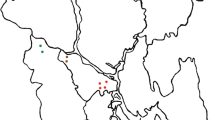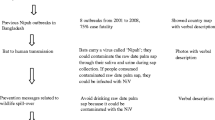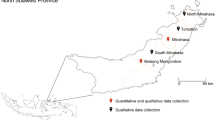Abstract
Human Nipah virus (NiV) infection, often fatal in Bangladesh, is primarily transmitted by drinking raw date palm sap contaminated by Pteropus bats. We assessed the impact of a behavior change communication intervention on reducing consumption of potentially NiV-contaminated raw sap. During the 2012–2014 sap harvesting seasons, we implemented interventions in two areas and compared results with a control area. In one area, we disseminated a “do not drink raw sap” message and, in the other area, encouraged only drinking sap if it had been protected from bat contamination by a barrier (“only safe sap”). Post-intervention, 40% more respondents in both intervention areas reported knowing about a disease contracted through raw sap consumption compared with control. Reported raw sap consumption decreased in all areas. The reductions in the intervention areas were not significantly greater compared to the control. Respondents directly exposed to the “only safe sap” message were more likely to report consuming raw sap from a protected source than those with no exposure (25 vs. 15%, OR 2.0, 95% CI 1.5–2.6, P < 0.001). While the intervention increased knowledge in both intervention areas, the “only safe sap” intervention reduced exposure to potentially NiV-contaminated sap and should be considered for future dissemination.

Similar content being viewed by others
References
Aspinall, E. J., D. Nambiar, D. J. Goldberg, M. Hickman, A. Weir, E. Van Velzen, N. Palmateer, J. S. Doyle, M. E. Hellard, and S. J. Hutchinson. 2014. Are needle and syringe programmes associated with a reduction in HIV transmission among people who inject drugs: a systematic review and meta-analysis. Int J Epidemiol 43:235–248.
BBS (2012) Population and Housing Census 2011, Dhaka, Bangladesh: Bangladesh Bureau of Statistics (BBS), Statistics and Informatics Division, Ministry of Planning
Chua, K. B., K. J. Goh, K. T. Wong, A. Kamarulzaman, P. S. Tan, T. G. Ksiazek, S. R. Zaki, G. Paul, S. K. Lam, and C. T. Tan. 1999. Fatal encephalitis due to Nipah virus among pig-farmers in Malaysia. Lancet 354:1257–1259.
Dawood, F. S., A. D. Iuliano, C. Reed, M. I. Meltzer, D. K. Shay, P. Y. Cheng, D. Bandaranayake, R. F. Breiman, W. A. Brooks, P. Buchy, D. R. Feikin, K. B. Fowler, A. Gordon, N. T. Hien, P. Horby, Q. S. Huang, M. A. Katz, A. Krishnan, R. Lal, J. M. Montgomery, K. Molbak, R. Pebody, A. M. Presanis, H. Razuri, A. Steens, Y. O. Tinoco, J. Wallinga, H. Yu, S. Vong, J. Bresee, and M. A. Widdowson. 2012. Estimated global mortality associated with the first 12 months of 2009 pandemic influenza A H1N1 virus circulation: a modelling study. Lancet Infect Dis 12:687–695.
Gurley, E. S., J. M. Montgomery, M. J. Hossain, M. Bell, A. K. Azad, M. R. Islam, M. A. Molla, D. S. Carroll, T. G. Ksiazek, P. A. Rota, L. Lowe, J. A. Comer, P. Rollin, M. Czub, A. Grolla, H. Feldmann, S. P. Luby, J. L. Woodward, and R. F. Breiman. 2007. Person-to-person transmission of Nipah virus in a Bangladeshi community. Emerg Infect Dis 13:1031–1037.
Hegde, S. T., H. M. Sazzad, M. J. Hossain, M. U. Alam, E. Kenah, P. Daszak, P. Rollin, M. Rahman, S. P. Luby, and E. S. Gurley. 2016. Investigating Rare Risk Factors for Nipah Virus in Bangladesh: 2001–2012. EcoHealth 13:720–728.
Homaira, N., M. Rahman, M. J. Hossain, J. H. Epstein, R. Sultana, M. S. Khan, G. Podder, K. Nahar, B. Ahmed, E. S. Gurley, P. Daszak, W. I. Lipkin, P. E. Rollin, J. A. Comer, T. G. Ksiazek, and S. P. Luby. 2010. Nipah virus outbreak with person-to-person transmission in a district of Bangladesh, 2007. Epidemiol Infect 138:1630–1636.
Khan, S. U., E. S. Gurley, M. J. Hossain, N. Nahar, M. A. Sharker, and S. P. Luby. 2012. A randomized controlled trial of interventions to impede date palm sap contamination by bats to prevent nipah virus transmission in Bangladesh. PLoS One 7:e42689.
Kirby D. B. (2008) The Impact of Abstinence and Comprehensive Sex and STD/HIV Education Programs on Adolescent Sexual Behavior. SR & SP 5:18–27.
Kish, L. 1949. A Procedure for Objective Respondent Selection within the Household. J Am Stat Assoc 44:380–387.
Luby, S., F. Hoodbhoy, A. Jan, A. Shah, and Y. Hutin. 2005. Long-term improvement in unsafe injection practices following community intervention. Int J Infect Dis 9:52–59.
Luby, S. P. 2013. The pandemic potential of Nipah virus. Antiviral Res 100:38–43.
Luby, S. P., M. Rahman, M. J. Hossain, L. S. Blum, M. M. Husain, E. Gurley, R. Khan, B. N. Ahmed, S. Rahman, N. Nahar, E. Kenah, J. A. Comer, and T. G. Ksiazek. 2006. Foodborne transmission of Nipah virus, Bangladesh. Emerg Infect Dis 12:1888–1894.
Marlatt, G. A. 1996. Harm reduction: come as you are. Addict Behav 21:779–788.
Nahar N, Asaduzzaman M, Sultana R, Garcia F, Paul RC, Abedin J, Sazzad HMS, Rahman M, Gurley ES, Luby SP (2017) A large-scale behavior change intervention to prevent Nipah transmission in Bangladesh: components and costs. BMC Res Notes 10:225.
Nahar, N., U. K. Mondal, M. J. Hossain, M. S. Khan, R. Sultana, E. S. Gurley, and S. P. Luby. 2014. Piloting the promotion of bamboo skirt barriers to prevent Nipah virus transmission through date palm sap in Bangladesh. Glob Health Promot 21:7–15.
Nahar, N., U. K. Mondal, R. Sultana, M. J. Hossain, M. S. Khan, E. S. Gurley, E. Oliveras, and S. P. Luby. 2013. Piloting the use of indigenous methods to prevent Nipah virus infection by interrupting bats’ access to date palm sap in Bangladesh. Health Promot Int 28:378–386.
Nahar, N., R. C. Paul, R. Sultana, E. S. Gurley, F. Garcia, J. Abedin, S. A. Sumon, K. C. Banik, M. Asaduzzaman, N. A. Rimi, M. Rahman, and S. P. Luby. 2015. Raw Sap Consumption Habits and Its Association with Knowledge of Nipah Virus in Two Endemic Districts in Bangladesh. PLoS One 10:e0142292.
Nahar, N., R. Sultana, E. S. Gurley, M. J. Hossain, and S. P. Luby. 2010. Date palm sap collection: exploring opportunities to prevent Nipah transmission. EcoHealth 7:196–203.
Nestle M, Wing R, Birch L, DiSogra L, Drewnowski A, Middleton S, Sigman-Grant M, Sobal J, Winston M, Economos C (1998) Behavioral and social influences on food choice. Nutr Rev 56:S50–64; discussion S64–74.
Plautz, A., and D. Meekers. 2007. Evaluation of the reach and impact of the 100% Jeune youth social marketing program in Cameroon: findings from three cross-sectional surveys. Reprod Health 4:1.
Rahman, M. A., M. J. Hossain, S. Sultana, N. Homaira, S. U. Khan, M. Rahman, E. S. Gurley, P. E. Rollin, M. K. Lo, J. A. Comer, L. Lowe, P. A. Rota, T. G. Ksiazek, E. Kenah, Y. Sharker, and S. P. Luby. 2012. Date palm sap linked to Nipah virus outbreak in Bangladesh, 2008. Vector Borne Zoonotic Dis 12:65–72.
Reynes, J. M., D. Counor, S. Ong, C. Faure, V. Seng, S. Molia, J. Walston, M. C. Georges-Courbot, V. Deubel, and J. L. Sarthou. 2005. Nipah virus in Lyle’s flying foxes, Cambodia. Emerg Infect Dis 11:1042–1047.
Sazzad, H. M., M. J. Hossain, E. S. Gurley, K. M. Ameen, S. Parveen, M. S. Islam, L. I. Faruque, G. Podder, S. S. Banu, M. K. Lo, P. E. Rollin, P. A. Rota, P. Daszak, M. Rahman, and S. P. Luby. 2013. Nipah virus infection outbreak with nosocomial and corpse-to-human transmission, Bangladesh. Emerg Infect Dis 19:210–217.
Sejvar, J. J., J. Hossain, S. K. Saha, E. S. Gurley, S. Banu, J. D. Hamadani, M. A. Faiz, F. M. Siddiqui, Q. D. Mohammad, A. H. Mollah, R. Uddin, R. Alam, R. Rahman, C. T. Tan, W. Bellini, P. Rota, R. F. Breiman, and S. P. Luby. 2007. Long-term neurological and functional outcome in Nipah virus infection. Ann Neurol 62:235–242.
Shepherd, R., and R. Shepherd. 2002. Resistance to changes in diet. Proc Nutr Soc 61:267–272.
Sultana R, Mondal UK, Abedin J, Hossain MJ, Sharkar MAY, Rimi NA, Gurley ES, Nahar N, Luby SP (2013) Evaluating long-term behavior change resulting from an intervention to prevent Nipah virus transmission from bats to humans in Bangladesh. Page p. 05.001 in International Meeting on Emerging Diseases and Surveillance, Vienna, Austria
Wacharapluesadee, S., B. Lumlertdacha, K. Boongird, S. Wanghongsa, L. Chanhome, P. Rollin, P. Stockton, C. E. Rupprecht, T. G. Ksiazek, and T. Hemachudha. 2005. Bat Nipah virus, Thailand. Emerg Infect Dis 11:1949–1951.
WHO (2016) Ebola situation report, World Health Organization
Wood, L., M. Egger, L. L. Gluud, K. F. Schulz, P. Juni, D. G. Altman, C. Gluud, R. M. Martin, A. J. Wood, and J. A. Sterne. 2008. Empirical evidence of bias in treatment effect estimates in controlled trials with different interventions and outcomes: meta-epidemiological study. BMJ 336:601–605.
Acknowledgements
Support for this study was provided by FHI 360 with funds from USAID Cooperative Agreement GHN-A-00-09-00002-00; this study was made possible by the generous support of the American people through the United States Agency for International Development (USAID). icddr,b acknowledges with gratitude the commitment of FHI 360 to the Centre’s research efforts. icddr,b is thankful to the Governments of Bangladesh, Canada, Sweden and the UK for providing core/unrestricted support. We are grateful to all the study participants for their valuable time. We are thankful to the quantitative data collection team. We acknowledge the continuous support of Professor Marcel Tanner from Swiss Tropical and Public Health Institute.
Author information
Authors and Affiliations
Corresponding author
Ethics declarations
Conflict of interests
Authors have no conflict of interest.
Human and Animal Rights
All procedures performed in studies involving human participants were in accordance with the ethical standards of the institutional and/or national research committee and with the 1964 Helsinki Declaration and its later amendments or comparable ethical standards. Written informed consent was obtained from all individual participants included in the study. Human subject review committees at icddr,b and FHI 360 approved the study protocol. The study protocol was registered as a clinical trial on clinicaltrials.gov (NCT01811784).
Appendix
Appendix
Rights and permissions
About this article
Cite this article
Nahar, N., Paul, R.C., Sultana, R. et al. A Controlled Trial to Reduce the Risk of Human Nipah Virus Exposure in Bangladesh. EcoHealth 14, 501–517 (2017). https://doi.org/10.1007/s10393-017-1267-4
Received:
Revised:
Accepted:
Published:
Issue Date:
DOI: https://doi.org/10.1007/s10393-017-1267-4




